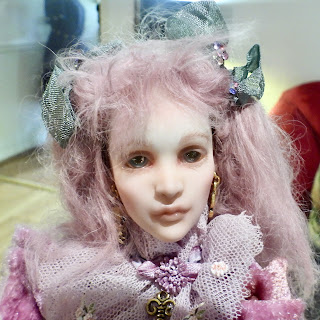Elaine Jackson did a program on Black cloth dolls. She used as a reference the catalog for “No Longer Hidden,” an exhibit at the Harvard Historical Society museum in 2007. The dolls were from the collection of Pat Hatch and the exhibit and book were by Robin Campbell.
Elaine noted that Black dolls have never been common. She explained that two factors made the development of Black cloth dolls possible, the production by cotton mills that made cotton fabric widely available and the invention of the sewing machine, which started to become commonplace in houses by the 1870s and made sewing clothing at home more convenient and affordable. Elaine said that subsequently bags of rags and fabric scraps became more common and could be used for everything from cleaning, creating rag rugs, to sewing cloth dolls. She explained that there few commercially made Black dolls, so many cloth Black dolls were made at home. Elaine stated that Black cloth dolls can be broken down into three eras. The earliest dolls, 1870 to 1890, were one-of-a-kind creations and beautifully made. These dolls are well proportioned and dressed, and often have applied ears and noses, as well as inset eyes. They were stuffed with bran, hay, or horsehair. During the second period, 1890 to 1910, as the dolls because popular and as more people made them, the quality began to decline. Shoe button eyes were often used at this time. Finally in the third period, the dolls became simpler and cruder with less individuality. They were stuffed with lighter material, such as cotton. Patterns became available in magazines. In the 1930s through 1950s, there were patterns for making “Mammy” dolls using bottles or jars or as toaster covers.
Elaine said that late in the first period to early in the second period, Julia Beecher created the Beecher babies, which had black stockinette faces with needle-sculpted features and eyes of black beads with the whites made from shell. This doll is an artist's interpretation of a Beecher baby.
Elaine told the club that this doll is probably one of the oldest in her collection. At one point she wore a bandana to cover her head.
This sweet set of sisters is from the 1920s or so. The blue dress and pinafore are original. The other doll has a pink replacement dress and a headdress made from a child's handkerchief.
This simple cloth doll was made as a craft project by students at Berea College in Kentucky. Elaine said that the college was founded in the 1850s as an integrated institution and that the students farmed and made crafts to pay their tuition. She stated that the school still has a craft store. This doll was created in the 1980s, but is based on an older pattern.
This is an example of a bottle doll. Magazines printed patterns for such dolls from the 1930s through the 1950s.
Her skirt hides a vintage bottle for rubbing alcohol.
Another bottle doll from Elaine's collection.
This little girl is made from a later pattern which formed a face with seam down each cheek. She was sold as a souvenir for New Orleans,
Elaine said that this doll was a gift from a friend. The doll was commercially created as a decorative item in the 1970s and resembles Beloved Belindy, a character from the Raggedly Ann book series,
This is Heather Matilda Miranda McGee, a homemade rag doll Elaine found in an antique shop in the 1980s. She is wearing a baby dress from the 1930s.
This cloth doll is a souvenir from the Caribbean. In the 1950s, such handcrafted creations were replaced by plastic dolls.
Member Bette Birdsong shared this doll she found in an antique shop in the 1960s. She said the doll probably dates from the 1930s.
Member Sharon Weintraub displayed a cloth topsy-turvy doll patented by the American firm of Albert Bruckner in 1901, with a Black doll on one side and a white doll on the other. This felt doll was commercially made in Italy by one of the competitors to the famous Lenci factory, such as Magis or Eros.
Member Pam Hardy shared this rag doll from the 1920s.
This cloth and wood black bunny belongs to member Sylvia McDonald.
Member Jan Irsfeld shared this character doll of mathematician Katherine Johnson made by Mattel.
Member Kenneth Reeves displayed this cute cloth doll by the Canadian company of Bamboletta. He said that the Waldorf-style doll was custom made for his niece from natural materials.
Member Myrna Loesch shared her new book on Cissy dolls created by Madame Alexander.
Member Jenell Howell displayed two dolls she acquired at the recent BJD convention in Austin. This doll is a one-of-a-kind 3D printed creation.
This wistful child is by artist Rose Bbflockling.


















.jpeg)






